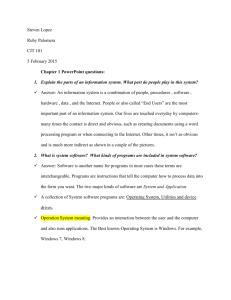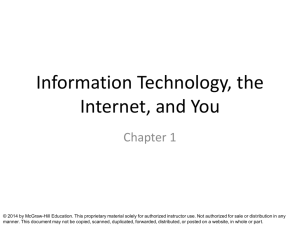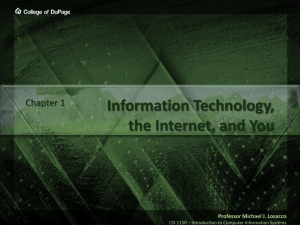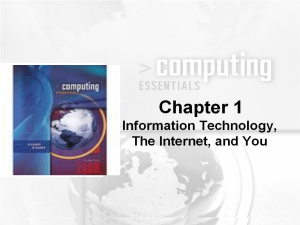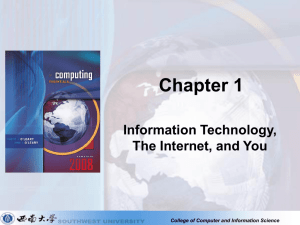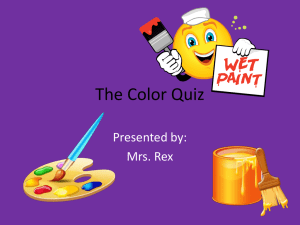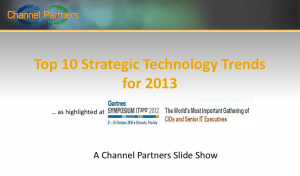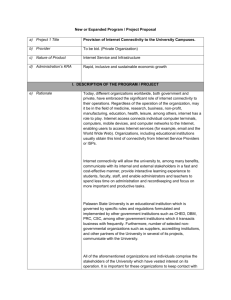Chapter 1 Outline
advertisement
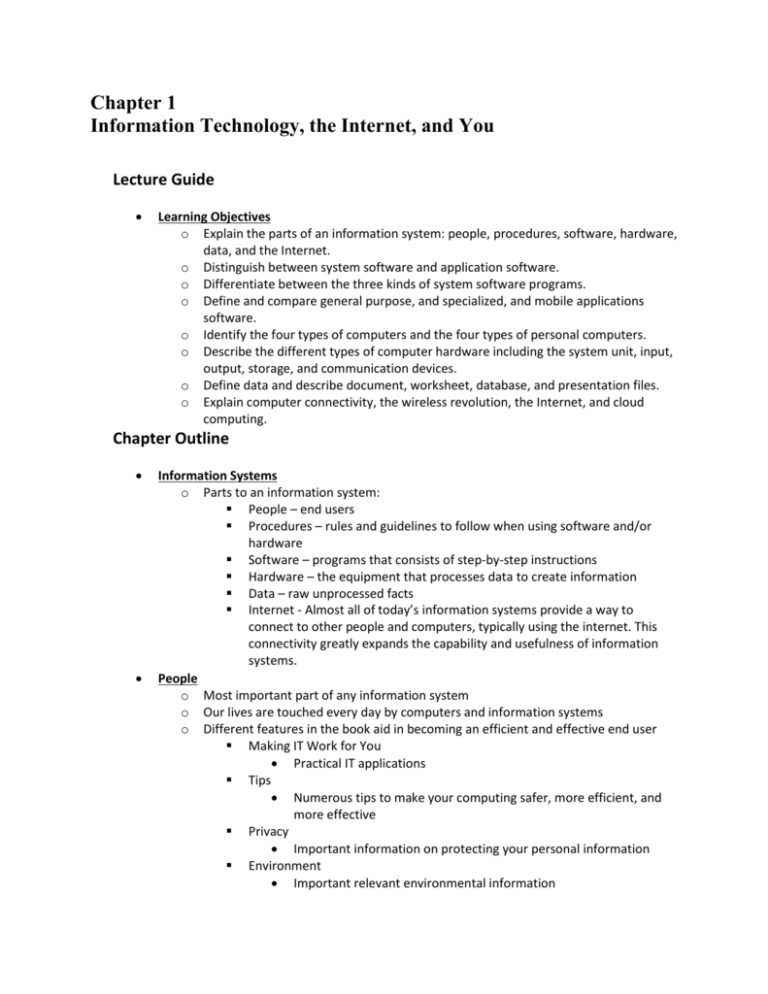
Chapter 1 Information Technology, the Internet, and You Lecture Guide Learning Objectives o Explain the parts of an information system: people, procedures, software, hardware, data, and the Internet. o Distinguish between system software and application software. o Differentiate between the three kinds of system software programs. o Define and compare general purpose, and specialized, and mobile applications software. o Identify the four types of computers and the four types of personal computers. o Describe the different types of computer hardware including the system unit, input, output, storage, and communication devices. o Define data and describe document, worksheet, database, and presentation files. o Explain computer connectivity, the wireless revolution, the Internet, and cloud computing. Chapter Outline Information Systems o Parts to an information system: People – end users Procedures – rules and guidelines to follow when using software and/or hardware Software – programs that consists of step-by-step instructions Hardware – the equipment that processes data to create information Data – raw unprocessed facts Internet - Almost all of today’s information systems provide a way to connect to other people and computers, typically using the internet. This connectivity greatly expands the capability and usefulness of information systems. People o Most important part of any information system o Our lives are touched every day by computers and information systems o Different features in the book aid in becoming an efficient and effective end user Making IT Work for You Practical IT applications Tips Numerous tips to make your computing safer, more efficient, and more effective Privacy Important information on protecting your personal information Environment Important relevant environmental information Ethics Variety of different ethical/unethical situations for your consideration Careers in IT Specific careers in information technology providing job descriptions, projected employment demands, educational requirements, current salary ranges and advancement opportunities. Computing Essentials Web site www.mhhe.com/ce2015 This site is integrated with the textbook for animations, career information, tips, test review materials and much more. Procedures o Computer users are required to follow rules or guidelines in order to effectively use software, hardware, and data. o Procedures are typically documented in manuals that are written by computer specialists. o Software and hardware manufacturers provide manuals with their products and are provided either printed or in electronic form. Software o Programs – the instructions that tell computers how to process data o Two major types of software: System Software Enables application software to interact with computer hardware A collection of programs o Operating system – coordinate the computer’s resources, provide a user interface, and run applications (ex: Windows 8, Mac OS X) o Utilities – perform specific tasks related to managing computer resources. The most essential utility programs that every computer system should have is an antivirus program. o Device drivers – specialized programs that allow input or output devices to communicate with the rest of the computer system Application Software End-user software Three types – general purpose, specialized, and mobile apps o General purpose application software that is used in nearly all careers (ex: browser, word processor, spreadsheet, data base management system, presentation graphics) o Specialized computer programs that are narrowly focused on specific disciplines and occupations (ex: graphics and Web authoring programs.). o Mobile apps or mobile applications, or simply apps, are small programs designed for mobile devices such as smartphones and tablet computers. The most popular mobile apps are for social networking, playing games, and downloading music and videos Hardware o Four types of computers Supercomputers Most powerful type of computer Special high-capacity computers Fastest processing Used by large organizations, usually research facilities Mainframe Capable of great processing speeds and large amounts of data storage Do not have as high of a capacity or as fast processing as supercomputers Used by large corporations Midrange Also referred to as servers Less powerful than a mainframe computer but more powerful than a personal computer Support end users for specific needs such as retrieving data from a database or supplying access to application software. Personal also known as Pcs Least powerful Most widely used Fastest growing segment Four types of personal computers include: o Desktops o Laptops o Tablets o Mobile devices also known as handhelds Smartphones most widely used handheld computer o Personal computer hardware System unit – micro-processor and memory (RAM) Input devices–keyboard and mouse Output devices-most common is computer display, or monitor Secondary storage – hard disks, solid-state storage, and optical disks Hard disks-store programs and very large data files Solid-state-no moving parts, reliable, requires less power Communication devices – modems Data o Raw unprocessed facts o Stored electronically in files o Four types of files include: Document files – created by word processors Worksheet files – created by electronic spreadsheets Database files – created by database management systems Presentation files - created by presentation graphics applications Connectivity o Connectivity is the capability of a personal computers to share information with other computers o Two most dramatic changes in connectivity in the past five years have been the widespread use of mobile or wireless communication devices and cloud computing o The wireless revolution, the ability to connect computers to each other without cables, is expected to dramatically affect the way we communicate and use computer technology. o A network is the central concept of connectivity – when two or more computers are connected. o The Internet is the largest computer network in the world. o The Web provides a multimedia interface to the resources available on the Internet. o Cloud computing uses the Internet and the Web to shift activities from the user’s computer to computers on the Internet. Careers in IT o There are different types of IT careers highlighted in each chapter Webmaster Software engineer Computer support specialist Computer technician Technical writer Network administrator A Look to the Future o Using and understanding information technology The purpose of this book is to help you use and understand information technology. The Internet and the Web are considered the two most important technologies of the 21st Century Powerful software is available to do extraordinary tasks Personal computers are more powerful than ever Privacy is necessary as technology can impact our personal private environment All organizations rely on the quality and flexibility of their information systems to stay competitive Computers are changing the way we do business, communicate, and live
